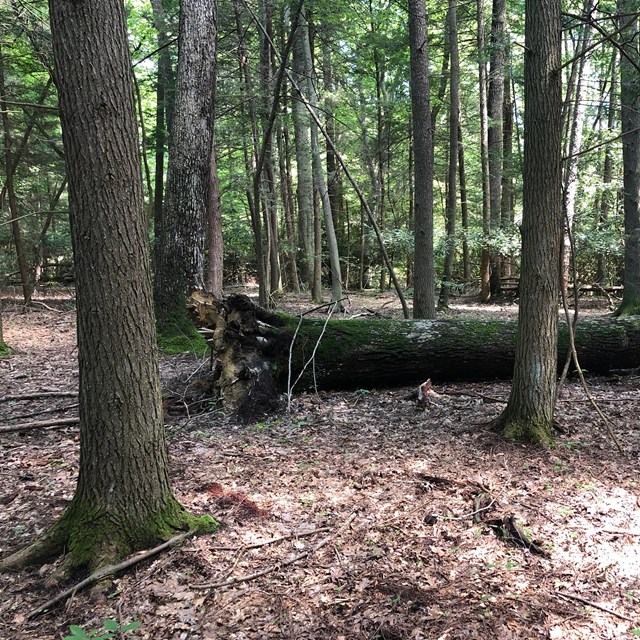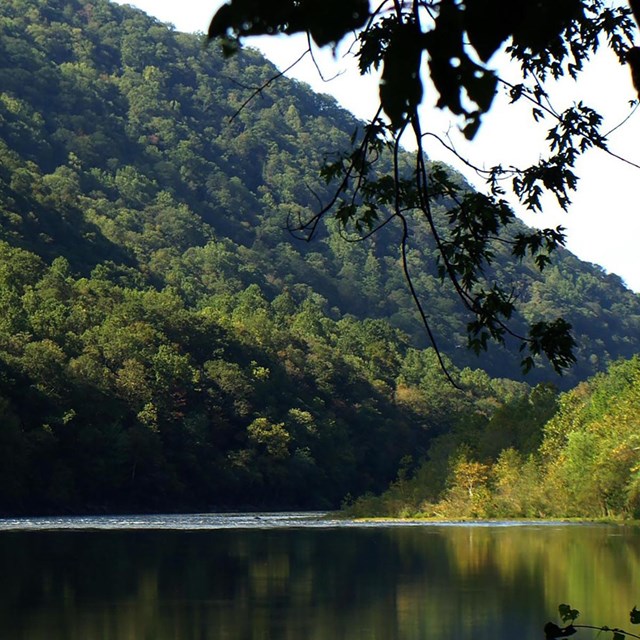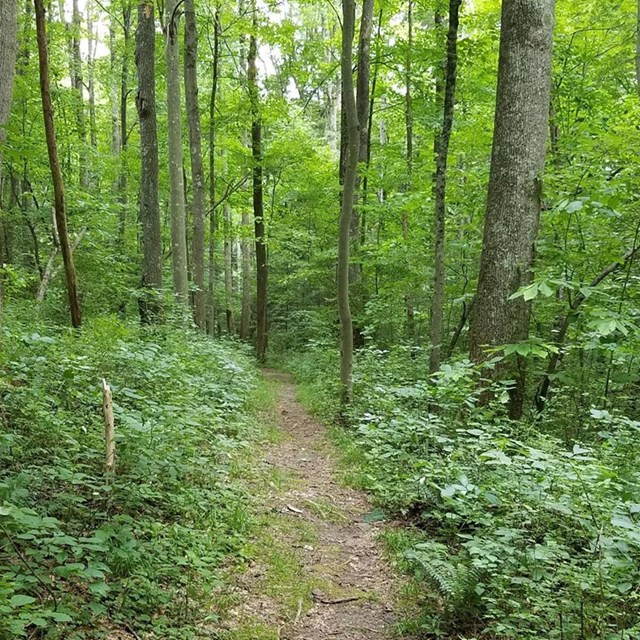
Tom Saladyga Old-growth forests provide a window into the historical forests that existed across much of the eastern United States before the major industrial land-use changes of the late 19th century. In places like the New River Gorge that were once full of industry, old-growth forests are rare. Settlers, developers, and coal and timber companies cleared much of the land for farms, mines, towns, and railroads. Two small patches of old-growth forest still exist within the park on both the Stone Cliff Trail and the Burnwood Trail. These undisturbed forests allow visitors and scientists to understand what original forests were like in this part of the country. 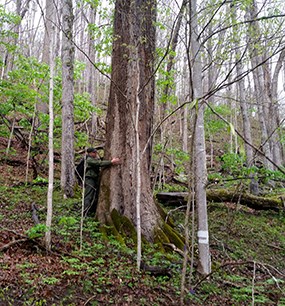
NPS / Dave Bieri What is an Old-Growth Forest?Old-growth forests have unique characteristics that highlight their age and showcase how natural processes have been allowed to shape the ecosystem. The forest's large trees are usually centuries old and some individual trees will be near their maximum potential age. The floor of the forest has abundant decomposing woody debris. Overhead, the tree canopies are multi-layered. These features add complexity to the forest and provide critical habitat. Many species of animals, birds, moss, and fungi rely on large trees and decomposing wood. Stone Cliff Old-Growth ForestIn 2015, 11 acres of forest past the endpoint of the Stone Cliff trail were identified as old-growth. On April 15, 2015, the Old Growth Forest Network inducted Stone Cliff into their network. This organization is the only national network in the United States of protected, old-growth, native forests. The goal of the organization is to dedicate at least one protected forest in each county within the United States that can sustain native forest. Multiple species of oaks, hickories, yellow buckeye, and beech are found in this forest. NOTE: This forest should only be explored by experienced off-trail, backcountry hikers. To access this forest, visitors must hike to the end of the 2.7 mile one-way Stone Cliff trail. To access the old-growth forest past the trail, off-trail trekking through rough, steep terrain with many downed trees and thick vegetation is required. The old-growth forest is both upslope and downslope of the unmaintained old roadbed past the Stone Cliff Trail. 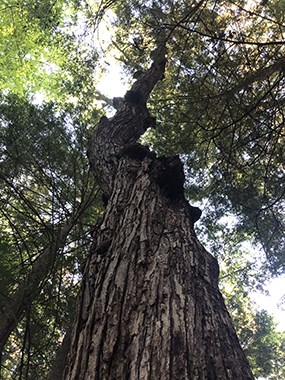
Tom Saladyga Burnwood Old-Growth ForestIn 2022, the National Park Service partnered with Dr. Tom Saladyga, Professor of Geography at Concord University in Athens, West Virginia, to conduct a research study in the forest along the Burnwood Trail. The study was part of an undergraduate class project that gave eight students the opportunity to perform scientific research within a national park. Their work led to a National Park Service natural resource report, Documenting Remnant Old Growth at New River Gorge National Park & Preserve: A Pre-Industrial Legacy Forest at the Burnwood Area. The report was the first research to document and confirm the Burnwood area as old-growth forest. Out of the fifty trees the team sampled, fifteen of them had ages that dated prior to the 1800s. Five trees established in the 1670s, being over 350 years old. Species dated include oaks, beech, hickories, blackgum, sourwood, and maples. Like Stone Cliff, the Old-Growth Forest Network recognized Burnwood as old-growth forest, inducting the trail into the network on August 4th, 2023. The Burnwood Trail is an easy to moderate 1.2 mile trail located right across US-19 from the Canyon Rim Visitor Center. A self-guided hike is available for visitors hiking on the trail. The Old-Growth Forest Hike has ten stops that are marked with numbered signage along the trail. The previous link includes the corresponding text that hikers can read as they reach each numbered stop along the trail.

Mark Strella & Kayla Green Transcript
The New River Gorge, as well as most of the eastern United States, used to be blanketed with old growth forests. Trees that would be 300, 400, even 500 years old, reaching high up into the canopy. But with the industrial logging boom that took place in the late 1800s throughout the early 1900s, left only a few patches of these forest remaining.
New research has been done at a forest in the New River Gorge at the Burnwood Trail, that shows that we have trees that date back Prior to the first European settlers that reached West Virginia. This tree I'm standing next to is a blackgum that dates back to 1671. The National Park Service partnered with Concord University professor, Dr. Tom Saladyga, who manages the Environmental Geography Lab at Concord University, where he led his students out here on the Burnwood Trail, to take some data and classify this area as an old growth forest, using the methods of dendrochronology. Dendrochronology takes tree rings samples from a tree, it's non-invasive and it won't kill a tree, then you can take those rings and assign calendar years to the actual trees themselves. And that's how we know some of these trees are over 350 years old. So our job here at the National Park Service is to manage and protect these lands. While we have the capacity to do some research and monitoring in-house, having partners like Concord University has really allowed us to better interpret this landscape so we can do a better job at preserving this and helping the public to understand what we have here on our public lands. I like getting hands on and being able to learn by doing the actual stuff without being taught in lecture. I've gotten to learn a lot of different tree species, how to core trees, and very important things that I find interesting. I feel like we've got a great opportunity to come out to the national park being here in West Virginia as well, it's a very diverse environment, and it's just nice to come out and enjoy our surroundings. What we're doing now is exactly what I want to be doing with my major. I hope to get on with some sort of Park Service to do national forest rehabilitation, so measuring trees, seeing what new species there are to come, is all very interesting to me. Old growth forests are characterized by large, mature trees that are reaching their end point of life, oftentimes being 300, 400, even 500 years old, but there's a lot of other ecological characteristics of old growth forests that make them unique and very beneficial for the ecosystem as a whole. Old growth forests often times have a lot of course woody debris on the ground that take a very long time to decompose. This great habitat for a lot of different species of animals, a lot of moss, fungi. Old growth forests also have multi-layered canopies, that then provide a lot of structure and complexity to a forest, that a younger forest generally doesn't have. Old growth forests also have really deep layers of soil that can store that can store large amounts of carbon, and store that carbon for a long period of time. What makes the Burnwood forest even more unique compared to other old growth forests within the region, is that its already on an established trail. The Burnwood Trail which is right across from the Canyon Rim Visitor Center, and it's also right across from the New River Gorge Bridge, which is one of West Virginia's most famous landmarks. Another thing about this forest that's unique is that it's on mostly flat terrain. Most old growth forests that still remain to this day, are usually on steep terrain, areas where it would've been hard to actually log because of how steep the topography would've been, but this is area is mostly on a flat trail. Having old growth like this permanently protected here in the national park for future generations, gives people the unique opportunity to see and experience what the original forests of New River Gorge looked like.
Visit our keyboard shortcuts docs for details
The Burnwood Trail at New River Gorge National Park and Preserve is one of only a few areas left that has old-growth forest. Thanks to a partnership with Concord University professor Dr. Tom Saladyga, the National Park Service has identified this rare piece of the landscape. Old-growth forest provides a window into the historical forests that existed before human industry boomed in the region. Visitors to the Burnwood Trail will hike through some trees that date back to the 1600s. Discover Old-Growth Forests
|
Last updated: September 10, 2025

